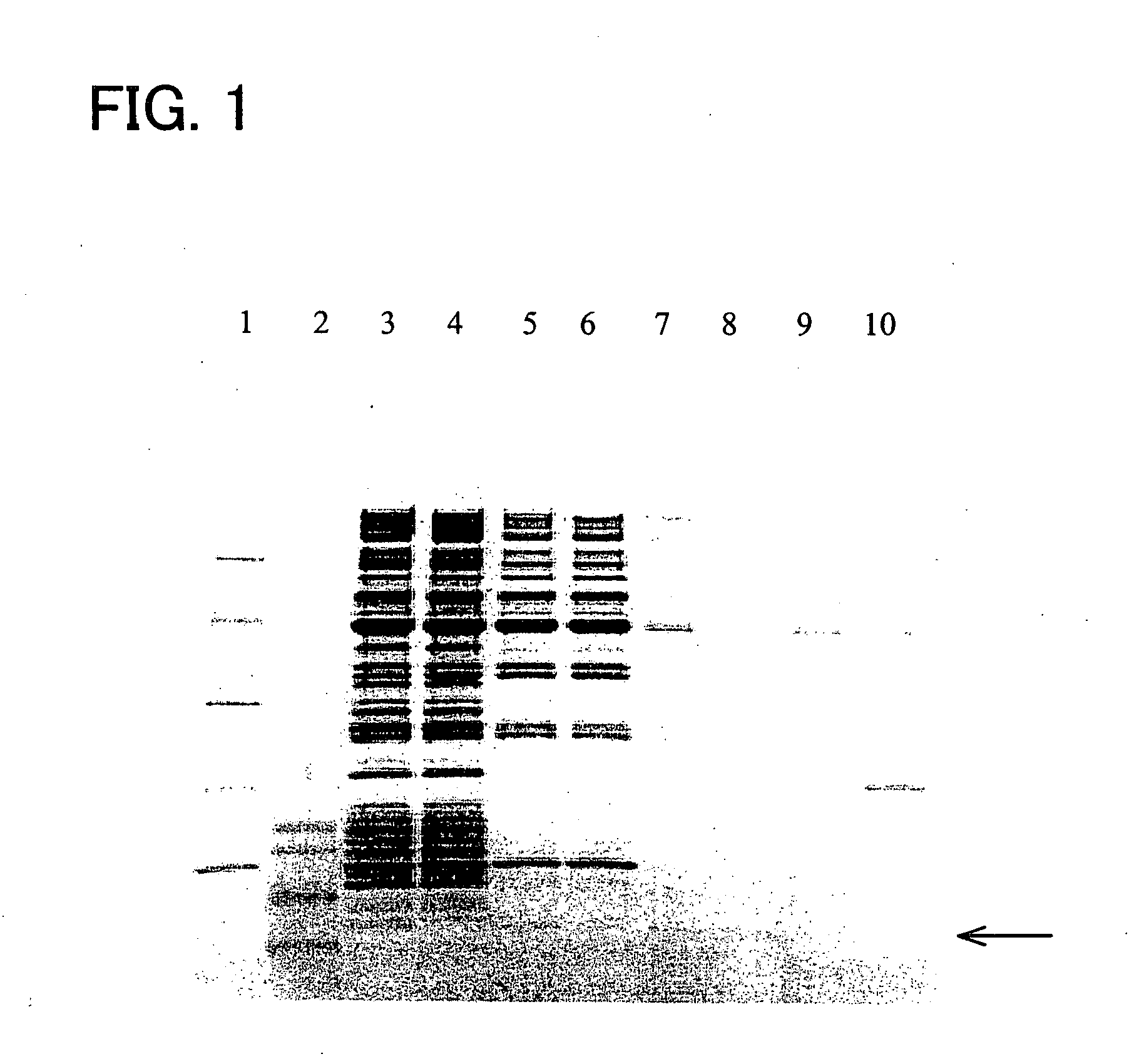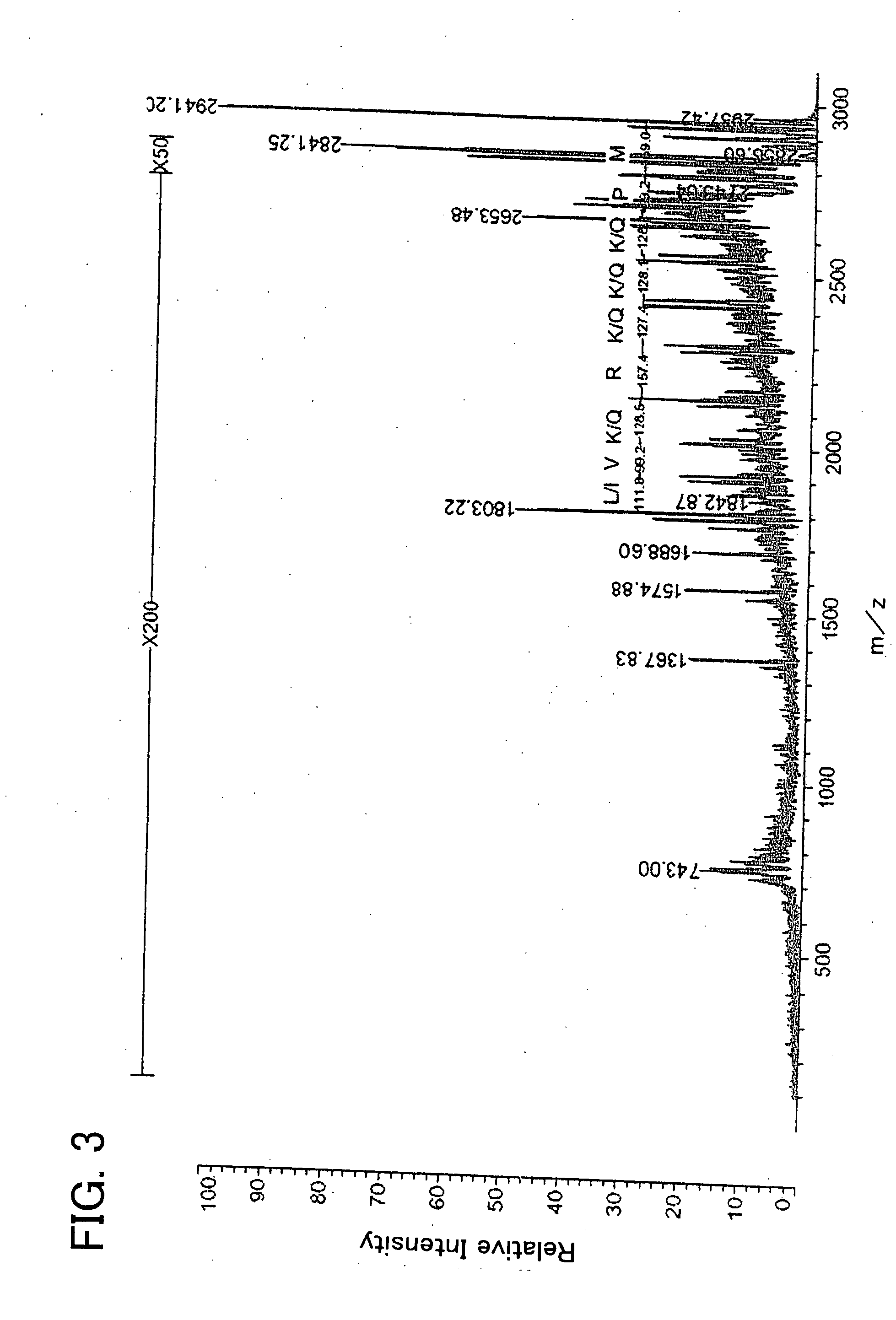Antimicrobial polypeptide and utilization thereof
a polypeptide and antimicrobial technology, applied in the field of antimicrobial polypeptides, can solve the problems of difficult to develop an antimicrobial agent with a better antibacterial activity or antibacterial spectrum than the polypeptide originally had in nature, and achieve the effects of improving antimicrobial activity, increasing the antimicrobial activity of the peptide, and enhancing the antimicrobial activity of the nls
- Summary
- Abstract
- Description
- Claims
- Application Information
AI Technical Summary
Benefits of technology
Problems solved by technology
Method used
Image
Examples
example 1
Chemical Synthesis of Antimicrobial Polypeptide
[0082] Thirty-six types of polypeptide (samples 1 to 33, comparative samples 1 to 3) were produced with a peptide synthesis machine that will be described later. Table 1 shows the amino acid sequences of these polypeptides.
TABLE 1total number ofamino acidsample No.amino acid sequenceresiduessample 1PKKKRKV (sequence No. 4)7sample 2RQARRNRRRRWR (sequence No. 21)12sample 3RIRKKLR (sequence No. 43)7sample 4PPRKKRTVV (sequence No. 28)9sample 5RKKRRQRRR (sequence No. 20)9sample 6PRRRK (sequence No. 26)5sample 7RKKKRKV (sequence No. 83)7sample 8PKKKRKVLPPLERLTL (sequence No. 84)16sample 9LPPLERLTLPKKKRKV (sequence No. 85)16sample 10RQARRNRRRRWRLPPLERLTLD (sequence No. 86)22sample 11PKKKRKVLPPLERLTLPKKKRKV (sequence No. 87)23sample 12RKKKRKVLPPLERLTL (sequence No. 88)16sample 13LPPLERLTLRKKKRKV (sequence No. 89)16sample 14RKKKRKVLALKLAGLDI (sequence No. 90)17sample 15LALKLAGLDIRKKKRKV (sequence No. 91)17sample 16PKKKRKVPKKKRKV (sequence No....
example 2
Antimicrobial Activity of Synthesized Polypeptide
[0108] Regarding the antimicrobial polypeptide of the present invention (samples 1 to 33) and the polypeptides of comparative samples 1 to 3, the antimicrobial activities (minimum inhibitory concentration: MIC) with respect to gram-negative bacteria (E. coli) and gram-positive bacteria (S. aureus) were determined by a liquid medium dilution technique using a 96-well microplate.
[0109] More specifically, liquid bouillon media (“NUTRIENT BROTH Dehydraged” manufactured by DIFCO) in a polypeptide concentration of 500, 250, 125, 62.5, 31.3, 15.6, 7.8, 3.9, 1.9, 1.0 and 0.5 μM were prepared, and filled in a 96-well microplate. On the other hand, bacteria suspension (about 2×106 cells / mL) that had been stationary cultured at 37° C. for 18 hours with LB Broth, Lennox (manufactured by DIFCO) were inoculated to each well of the 96-well microplate in an equal amount to that of the pharmaceutical solution (the above-described polypeptide-contain...
example 3
Antimicrobial Spectrum
[0115] Next, regarding the polypeptides of the samples 16, 17, 10, 14, and 20, the same antimicrobial test (MIC measurement test) as in Example 2 was performed with respect to various bacteria (see Table 3), and the antimicrobial spectra of these polypeptides were evaluated. As a result, as shown in Table 3, it was confirmed that the antimicrobial polypeptide of the present invention had antimicrobial activities with respect to a wide range of gram-positive bacteria and gram-negative bacteria.
TABLE 3antimicrobial activity after 24 hours: MIC (μM)samplesamplesamplesamplesamplebacteria tested1617101420Bacillus cereus>286.0>260.321.432.0>267.9IFO3001Bacillus cereus>286.0>260.342.964.1133.9IFO15305Bacillus pumilus143.016.35.44.016.7IFO3813Bacillus brevis>286.0>260.321.4128.2133.9IFO15304Bacillus subtilis2.21.00.71.02.1ATCC6633Bacillus subtilis8.90.50.71.04.2IFO3134Micrococcus luteus8.94.15.44.08.4IFO12708Staphylococcus aureus>286.016.310.716.033.5COL (MRSA)Staph...
PUM
| Property | Measurement | Unit |
|---|---|---|
| Fraction | aaaaa | aaaaa |
| Fraction | aaaaa | aaaaa |
| Fraction | aaaaa | aaaaa |
Abstract
Description
Claims
Application Information
 Login to view more
Login to view more - R&D Engineer
- R&D Manager
- IP Professional
- Industry Leading Data Capabilities
- Powerful AI technology
- Patent DNA Extraction
Browse by: Latest US Patents, China's latest patents, Technical Efficacy Thesaurus, Application Domain, Technology Topic.
© 2024 PatSnap. All rights reserved.Legal|Privacy policy|Modern Slavery Act Transparency Statement|Sitemap



